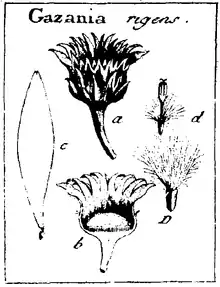Gazania
Gazania /ɡəˈzeɪniə/[3] is a genus of flowering plants in the family Asteraceae, native to Southern Africa.[4][5][1][6]
| Gazania | |
|---|---|
 | |
| Gazania rigens | |
| Scientific classification | |
| Kingdom: | |
| (unranked): | |
| (unranked): | |
| (unranked): | |
| Order: | |
| Family: | |
| Subfamily: | |
| Tribe: | Arctotideae |
| Genus: | Gazania |
| Type species | |
| Gazania rigens[1] | |
| Synonyms[2] | |
| |
They produce large, daisy-like composite flowerheads in brilliant shades of yellow and orange, over a long period in summer.[7] They are often planted as drought-tolerant groundcover.
Taxonomic history


The genus was first formally described by German botanist Joseph Gaertner in the second volume of his major work De Fructibus et Seminibus Plantarum in 1791.[8] Gaertner named the genus after Theodorus Gaza, a 15th-century translator of the works of Theophrastus.[9]
Gazania is a member of the tribe Arctotideae and the subtribe Gorteriinae. Within the subtribe it is close to Hirpicium and Gorteria.[10] Many of the species of Gazania are hard to distinguish and the number of species assigned to the genus has varied widely from one author to another.
In 1959, Helmut Roessler published what he considered to be a preliminary revision of Gazania. At that time, he recognized 16 species.[11] Roessler published some amendments to his treatment in 1973.[12]
In 2009, a phylogeny of the genus was published. It was based on molecular phylogenetic analysis of chloroplast and nuclear DNA sequences.[9] In this study, all of Roessler's species except Gazania othonnites were sampled. The authors found that eight species were not really separate, but formed a species complex. The seven species found to be distinct were G. jurineifolia, G. caespitosa, G. ciliaris, G. tenuifolia, G. heterochaeta, G. schenckii, and G. lichtensteinii.
Distribution
The genus occurs from low-altitude sands to alpine meadows[7] in South Africa, Swaziland, Mozambique, Tanzania, and Angola.[8] Additionally, species are naturalised and declared weed in South Australia, New Zealand, the Mediterranean, and California.[8][13]
Cultivation
Gazania species are grown for the brilliant colour of their flowerheads which appear in the late spring and are often in bloom throughout the summer into autumn. They prefer a sunny position and are tolerant of dryness and poor soils.[14]
Numerous cultivars have been selected for variety of colour and habit. In temperate regions, they are usually grown as half-hardy annuals.[7] A commonly grown variety is the trailing gazania (Gazania rigens var. leucolaena). It is commonly used as groundcover and can be planted en masse to cover large areas or embankments, assisted by its fast growth rate. Cultivars of this variety include 'Sunburst', 'Sunglow', and 'Sunrise Yellow'.[14] Another popular cultivated variety is the clumping gazania (Gazania rigens), which has a number of named cultivars including 'Aztec', 'Burgundy', 'Copper King', 'Fiesta Red', 'Goldrush' and 'Moonglow'. [14]
The following cultivars have gained the Royal Horticultural Society’s Award of Garden Merit:-[15]
Species[2][20]
- Gazania caespitosa Bolus
- Gazania ciliaris DC.
- Gazania heterochaeta DC.
- Gazania jurineifolia DC.
- Gazania krebsiana Less. - Terracotta Gazania
- Gazania lichtensteinii Less..
- Gazania leiopoda (DC.) Roessler
- Gazania linearis (Thunb.) Druce - Treasureflower
- Gazania maritima Levyns
- Gazania othonnites (Thunb.) Less.
- Gazania pectinata (Thunb.) Hartw.
- Gazania pinnata DC.
- Gazania rigens (L.) Gaertn.
- Gazania rigida (Burm.f.) Roessler
- Gazania schenckii O.Hoffm.
- Gazania serrata DC.
- Gazania tenuifolia Less.
- Gazania thermalis Dinter
Gallery
 Gazania krebsiana Goegap N.R., Namaqualand, Northern Cape, South Africa
Gazania krebsiana Goegap N.R., Namaqualand, Northern Cape, South Africa Gazania lichtensteinii Goegap N.R., Namaqualand, Northern Cape, South Africa
Gazania lichtensteinii Goegap N.R., Namaqualand, Northern Cape, South Africa Gazania rigens (flower)
Gazania rigens (flower) White and purple gazania
White and purple gazania.jpg.webp) Yellow and White variety of Gazania rigens
Yellow and White variety of Gazania rigens Orange gazania in Palestine
Orange gazania in Palestine Orange gazania in Palestine
Orange gazania in Palestine
See also
References
- Tropicos, Gazania Gaertn.
- Flann, C (ed) 2009+ Global Compositae Checklist
- Sunset Western Garden Book, 1995:606–607
- Gaertner, Joseph. 1791. De fructibus et seminibus plantarum 2(3): 451–452 in Latin
- Gaertner, Joseph. 1791. De fructibus et seminibus plantarum 2(3): plate CLXXIII (173) line drawing of Gazania rigens
- Per Ola Karis. 2007. "Arctotideae" pages 200-207. In: Klaus Kubitzki (series editor); Joachim W. Kadereit and Charles Jeffrey (volume editors). The Families and Genera of Vascular Plants volume VIII. Springer-Verlag: Berlin; Heidelberg, Germany.
- RHS A-Z encyclopedia of garden plants. United Kingdom: Dorling Kindersley. 2008. p. 1136. ISBN 978-1405332965.
- "Aluka - Entry for Gazania Gaertn. [family COMPOSITAE]". Archived from the original on 2013-08-01. Retrieved 2008-04-11.
- Seranne Howis, Nigel P. Barker, and Ladislav Mucina. 2009. "Globally grown, but poorly known: species limits and biogeography of Gazania Gaertn. (Asteraceae) inferred from chloroplast and nuclear DNA sequence data". Taxon 58(3):871-882.
- Vicki A. Funk and Raymund Chan. 2008. "Phylogeny of the Spiny African Daisies (Compositae, tribe Arctotideae, subtribe Gorteriinae) based on trnL-F, ndhF, and ITS sequence data". Molecular Phylogenetics and Evolution 48(1):47-60.
- Helmut Rössler. 1959. "Revision der Arctotideae - Gorteriinae (Compositae)". Mitteilungen der Botanischen Staatssammlung München 3:71-500.
- Helmut Roessler. 1973. Mitteilungen der Botanischen Staatssammlung Muenchen 11:91-99.
- "Genus Gazania". PlantNET - New South Wales Flora Online. Royal Botanic Gardens & Domain Trust, Sydney Australia. Retrieved 2008-04-11.
- Arthurs, Kathryn L. (ed.) (1979). Lawns & Groundcovers. Lane Publishing Co. ISBN 9780376035073.CS1 maint: extra text: authors list (link)
- "AGM Plants - Ornamental" (PDF). Royal Horticultural Society. July 2017. p. 39. Retrieved 27 February 2018.
- "RHS Plantfinder - Gazania 'Aztec'". Retrieved 27 February 2018.
- "RHS Plantfinder - Gazania 'Cookei'". Retrieved 27 February 2018.
- "RHS Plantfinder - G. rigens 'Variegata'". Retrieved 27 February 2018.
- "RHS Plantfinder - Gazania Talent Series". Retrieved 27 February 2018.
- "African plants database". Retrieved 2008-04-11.